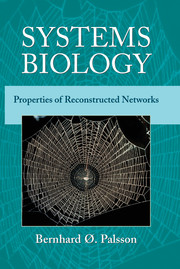Book contents
- Frontmatter
- Contents
- Preface
- 1 Introduction
- 2 Basic Concepts in Systems Biology
- PART I RECONSTRUCTION OF BIOCHEMICAL NETWORKS
- PART II MATHEMATICAL REPRESENTATION OF RECONSTRUCTED NETWORKS
- PART III CAPABILITIES OF RECONSTRUCTED NETWORKS
- APPENDIX A Nomenclature and Abbreviations
- APPENDIX B E. coli Core Metabolic Network
- Bibliography
- Index
PART II - MATHEMATICAL REPRESENTATION OF RECONSTRUCTED NETWORKS
Published online by Cambridge University Press: 05 September 2012
- Frontmatter
- Contents
- Preface
- 1 Introduction
- 2 Basic Concepts in Systems Biology
- PART I RECONSTRUCTION OF BIOCHEMICAL NETWORKS
- PART II MATHEMATICAL REPRESENTATION OF RECONSTRUCTED NETWORKS
- PART III CAPABILITIES OF RECONSTRUCTED NETWORKS
- APPENDIX A Nomenclature and Abbreviations
- APPENDIX B E. coli Core Metabolic Network
- Bibliography
- Index
Summary
The set of chemical reactions that comprise a network can be represented as a set of chemical equations. Embedded in these chemical equations is information about reaction stoichiometry. All this stoichiometric information can be represented in a matrix form; the stoichiometric matrix, denoted by S. Associated with this matrix is additional information about enzyme complex formation, transcript levels, open reading frames, and protein localization. Therefore, once assembled, the stoichiometric matrix represents a biochemically, genetically, and genomically (BIGG) structured database. This database structure represents an interface between high-throughput data and in silico analysis (see Figure 1.4). It allows high-throughput data (often called content) to be put into context. The stoichiometric matrix is the starting point for various mathematical analysis used to determine network properties. Part II of this text will summarize the basic properties of the stoichiometric matrix. Since it is a mathematical object, the treatment is necessarily mathematical. However, S represents biochemistry. We will thus relate the mathematical properties of S to the biochemical and biological properties that it fundamentally represents.
- Type
- Chapter
- Information
- Systems BiologyProperties of Reconstructed Networks, pp. 87 - 88Publisher: Cambridge University PressPrint publication year: 2006



